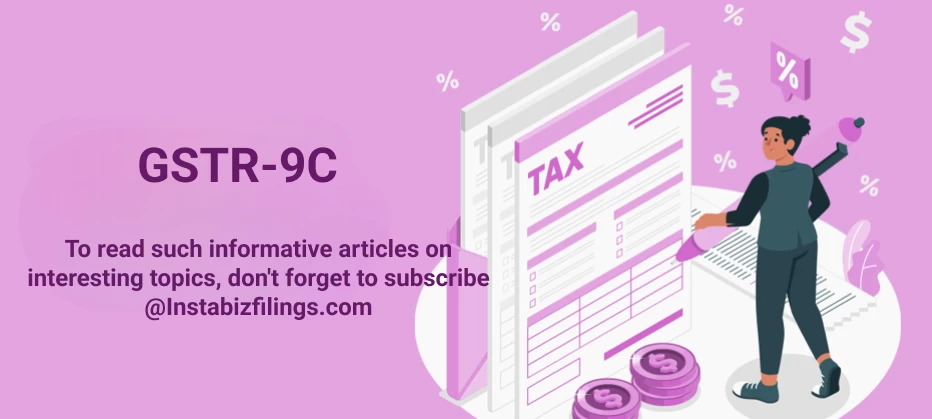
GSTR-9C
April 10, 2025 by Team Instabizfilings
What is GSTR-9C?
GSTR-9C is a GST audit report that taxpayers with an annual turnover of more than ₹5 crores must file. It acts as a reconciliation statement between the taxpayer’s GST returns (GSTR-9) and their audited financial statements. It must be certified by a Chartered Accountant (CA) or a Cost Accountant before submission.
Purpose of GSTR-9C
-
The reconciliation process checks that turnover amounts along with tax payments together with input tax credit (ITC) claims in financial records matches the information presented in GST returns.
-
Auditors check whether a taxpayer fulfills their GST requirements by ensuring proper return submissions and accurate document submission.
-
The system enables users to detect any inconsistency between tax obligations and Input Tax Credit demands and payment activities.
Who Needs to File GSTR-9C?
- Mandatory for:
-
Taxpayers whose annual turnover exceeds ₹5 crores in a financial year.
-
Taxpayers filing GSTR-9 (Annual Return).
- Not required for:
-
Taxpayers with turnover below ₹5 crores.
-
Composition scheme taxpayers.
-
Non-resident taxable persons, input service distributors (ISD), casual taxable persons, and e-commerce operators not liable for tax collection at source (TCS).
Due Date for Filing GSTR-9C
-
The due date for GSTR-9C is 31st December of the following financial year (same as GSTR-9).
-
The government may extend the due date based on industry requests.
Penalty for Late Filing of GSTR-9C
-
Additional fees amount to ₹200 for each day (composed of ₹100 CGST and ₹100 SGST) but do not exceed 0.50% of the business turnover.
-
Tax penalties through Section 73 or 74 of the GST Act can be imposed in cases where tax discrepancies result in reductions of payment amounts.
How to File GSTR-9C?
GSTR-9C must be prepared and certified by a CA or Cost Accountant before submission.
- Step 1: Gather Required Documents
-
Audited Financial Statements (Profit & Loss Account, Balance Sheet, etc.).
-
GSTR-9 Annual Return filed for the same financial year.
-
GST Ledger Details (ITC claimed, tax paid, outward and inward supplies).
- Step 2: Log in to the GST Portal
-
Users can reach www.gst.gov.in where they must log in with their registered credentials.
-
Go to "Services" → "Returns" → "Annual Return" and select GSTR-9C.
- Step 3: Fill in GSTR-9C Details
- GSTR-9C consists of two main parts:
Part A: Reconciliation Statement
This section compares financial statements with GST returns to identify mismatches.
-
Turnover Reconciliation
- Report annual turnover as per audited financials and GSTR-9.
- Adjust for unbilled revenue, export sales, deemed supply, etc.
-
Tax Paid Reconciliation
- Compare tax paid in GSTR-9 with tax payable per financial records.
- Identify differences in CGST, SGST, IGST, and Cess.
-
ITC Reconciliation
- Report ITC claimed in books vs. ITC claimed in GSTR-9.
- Adjust for ineligible ITC, reversals, and mismatches.
-
Additional Liability (If Any)
- If discrepancies result in a higher tax liability, the taxpayer must pay the difference using Form DRC-03.
Part B: Certification by CA/Cost Accountant
-
A Chartered Accountant (CA) or Cost Accountant must review and certify the reconciliation statement.
-
The auditor must confirm:
- GST compliance accuracy.
- Proper tax payment.
- Correct ITC claims.
- Step 4: Submit and File GSTR-9C
-
Upload the auditor’s certified reconciliation statement.
-
You need to file documentation through either DSC (Digital Signature Certificate) or EVC (Electronic Verification Code).
Key Differences: GSTR-9 vs. GSTR-9C
|
Aspect |
GSTR-9 |
GSTR-9C |
|
Type of Return |
Annual Return |
Audit Report & Reconciliation |
|
Applicability |
Turnover > ₹2 crores |
Turnover > ₹5 crores |
|
Purpose |
Summary of GST transactions |
Verification of GSTR-9 with financial statements |
|
Filing Authority |
Taxpayer |
Certified by CA/Cost Accountant |
|
Requirement |
Mandatory for turnover > ₹2 crore |
Mandatory for turnover > ₹5 crore |
|
Penalty for Late Filing |
₹200/day |
₹200/day + audit scrutiny if discrepancies found |
Common Mistakes to Avoid While Filing GSTR-9C
-
Mismatch in Turnover Reporting : Ensure that turnover in GSTR-9, GSTR-3B, and financial statements match.
-
Incorrect ITC Claims : Cross-check ITC claims in books vs. GSTR-2A/GSTR-2B to avoid discrepancies.
-
Ignoring Tax Differences : If tax paid in GSTR-3B is less than actual liability, the taxpayer must pay the difference with interest.
-
Not Reconciling GSTR-1 with GSTR-3B : Ensure that outward supply details match across returns to avoid audit red flags.
-
Filing Without Proper Audit : Get GSTR-9C reviewed and certified only by a CA or Cost Accountant.
Conclusion
GSTR-9C is an important reconciliation statement that ensures transparency in GST compliance for businesses with turnover above ₹5 crores. Filing it accurately helps taxpayers avoid penalties and ensures compliance with GST laws.
Since it involves an audit and certification, businesses should work closely with chartered accountants or cost accountants to ensure proper reconciliation and error-free filing.
Disclaimer
The information provided in this blog is purely for general informational purposes only. While every effort has been made to ensure the accuracy, reliability and completeness of the content presented, we make no representations or warranties of any kind, express or implied, for the same.
We expressly disclaim any and all liability for any loss, damage or injury arising from or in connection with the use of or reliance on this information. This includes, but is not limited to, any direct, indirect, incidental, consequential or punitive damage.
Further, we reserve the right to make changes to the content at any time without prior notice. For specific advice tailored to your situation, we request you to get in touch with us.


